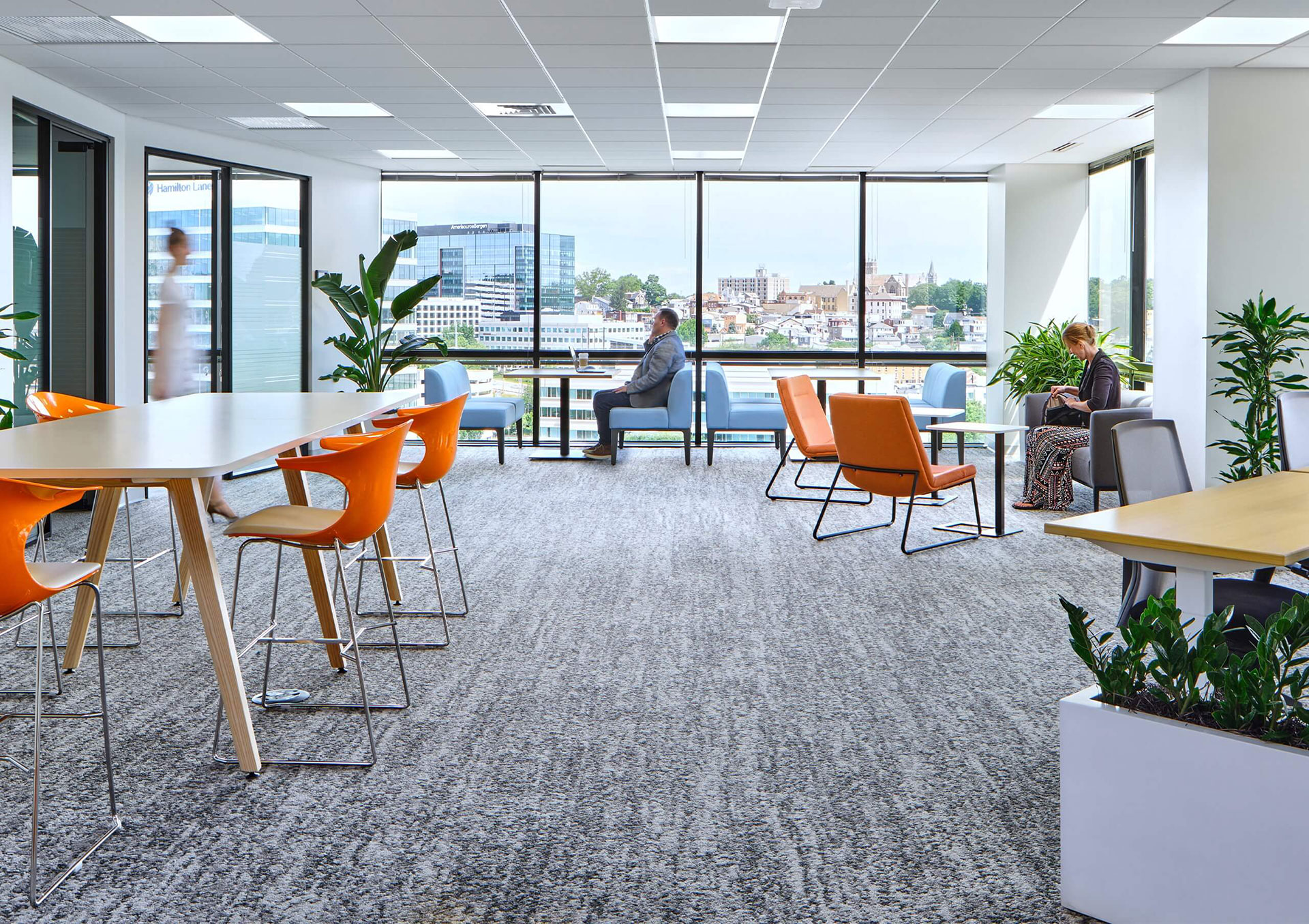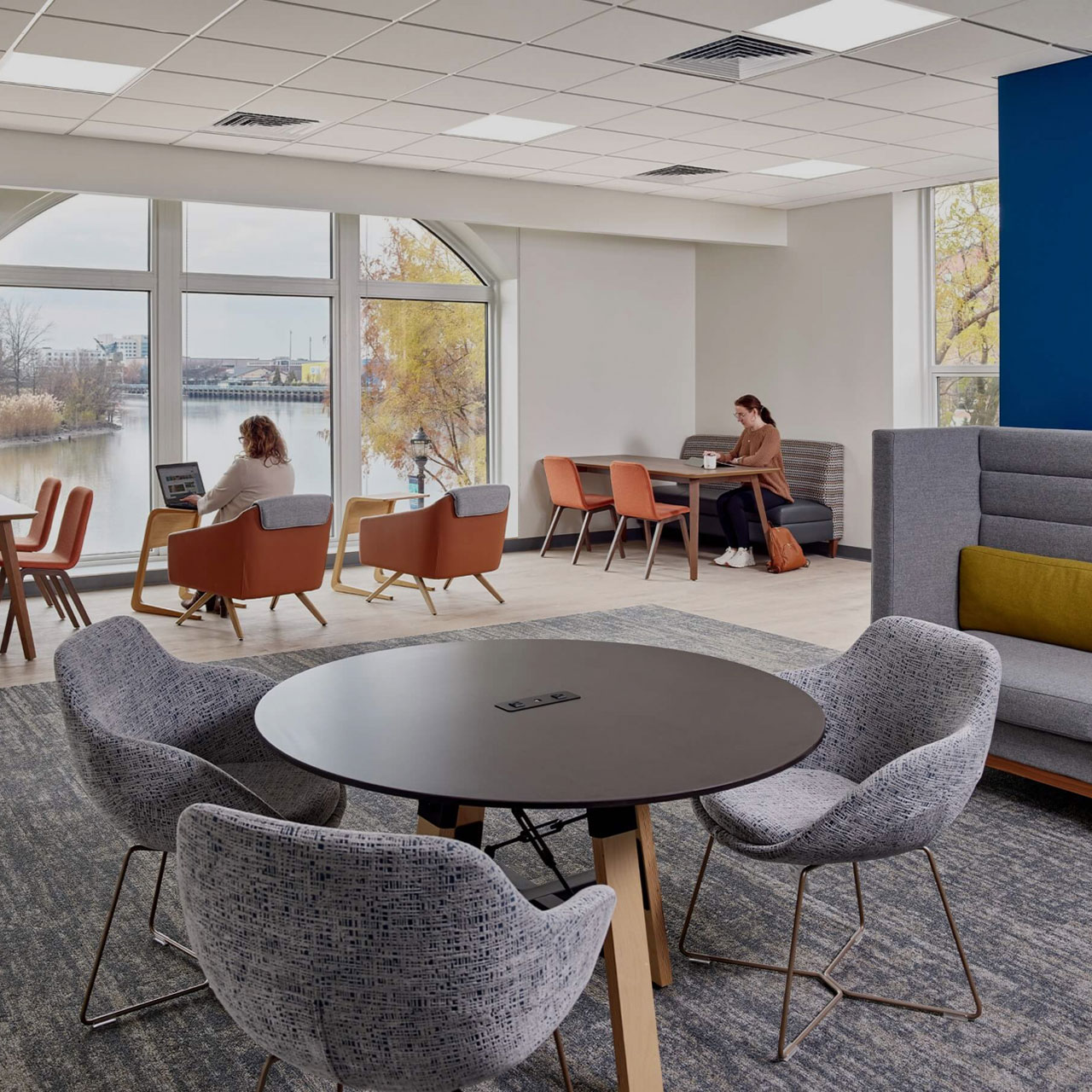6 Office Design Trends for the Future of Work
Work has changed dramatically over the last few years—and the workplace is changing along with it. Companies are embracing a more people-centered approach to office design to answer workers’ current needs. At the same time, organizations have had to be more strategic in planning and implementing space design projects. Here are six trends in office design for 2023.


1. Task-Based Planning
With task-based planning, form meets function. While traditional office design tended to focus on hierarchies and seniority, this approach prioritizes creating spaces that support the tasks and functions that need to be performed in the office. The emphasis here is on flexibility and adaptability, so space can be reconfigured to meet the needs of different tasks and projects. That means:
- Enabling an agile approach to individual workseats
- Providing space type variety to support different job tasks
- Using furniture and accessories to divide space rather than hard walls
Once limited to more forward-thinking organizations, a task-based approach to planning is increasing in popularity as more companies adopt flexible and remote work policies. This strategy empowers workers to choose the spaces and resources needed for varying tasks throughout their day. Task-based planning can also provide a more effective use of space, allowing companies to maximize their resources and accommodate a wider range of workstyles and activities.
This Innovation Hub design for a financial services company is a good example of task-based planning. For this project, several existing executive offices in a prime but underused location were transformed into one multi-functional space supporting both formal and informal collaboration, a variety of meeting sizes, and individual focus work in a comfortable, hospitable setting. Furniture is lightweight and easily moved; the design includes a glass partition that can be opened or closed to create additional privacy.
2. Small Meeting Rooms and Private Focus Space
As many office spaces become more open and flexible, people working in these spaces will need more small meeting and private areas for focus and retreat. Smaller focus spaces provide much-needed acoustical or visual separation for discussions, calls and video conferencing. The most-used meeting spaces are those that are comfortable, easy to get to, and equipped with the right hardware, acoustics and lighting for video calling. Trends to watch:
- Increased variety in meeting room sizes and furniture settings
- Improved lighting, acoustics, technology, and aesthetics
- Unassigned huddle spaces or pods for unscheduled, drop-in use
More ideas for supporting hybrid workers
3. Space Use & Policy Development
Successful spaces are underpinned by thoughtful intent. Strategic discussions informed by the company’s goals, vision and organizational function should guide an approach to space design. Among other important considerations, leadership should develop and communicate a unified approach to hybrid or remote work. This includes building appropriate support for both newer and established employees who may be shifting from one mode of work to another with the development of a new space design.
Leaders should be asking: What kinds of activities need to happen in the office, and what kinds of spaces are required to support those activities? Strategic design starts with close partnerships between leadership, HR, and IT to align expectations, infrastructure, and implementation.
The TransCelerate BioPharma team employed these principles in designing the company’s new office in Conshohocken, PA. The intent was to provide an attractive, people-centered design, centered on flexibility and connectivity and supporting a hybrid work model. Special consideration for the needs of both in-person and remote workers drove the project strategy.
Successful, well-used spaces tend to reflect three major organizational conditions.
- Support for in-person functions or activities that cannot be replicated remotely
- Technology systems supporting easy switching between remote, hybrid and in-person work
- Attendance policies related to specific job requirements and a positive, clearly communicated business vision
4. A Master Services Approach to Planning and Build-Out
Whether planning a brand-new build or retrofitting an existing space, commercial office projects can be extended, complicated endeavors. Within the context of ever-rising construction costs and supply chain issues, the process requires a serious investment in time, attention, and money. Many organizations are interested in streamlining their commitment and therefore turn to a master services approach, in which a single entity is responsible for coordinating all aspects of the project, from design and planning to construction and post-occupancy services.
Working with a design-build company—where design, preconstruction, and construction are all housed under one roof—can be especially beneficial for organizations with multiple locations or highly complex projects. A master services approach provides several distinct benefits, such as a single point of contact for the project, streamlined communication and decision-making, and increased efficiency and cost-effectiveness. Design-build partners can also help to improve communication between suppliers and therefore reduce the risk of disputed and delays.
Taking into consideration supply chain issues, many organizations find it especially helpful to partner with firms taking active responsibility for procurement and planning. Helpful strategies include:
- Full schedule development within the earliest phases of design
- Coordinating for expedited design and procurement of engineering systems
- Early release for order and stockpile of project materials upon selection
- Budgeting to include escalation contingencies
5. Creating a Welcoming Office Culture
Creating a welcoming office culture is important for attracting and retaining top talent. Employers should strive to provide a positive work environment to help employees feel valued and supported. Successful organizational cultures will:
- Embrace diversity, equity and inclusion: Understanding and supporting differences in race, ethnicity, sexuality and gender as well as socioeconomic background, family structure, neurodiversity, and work preference
- Support choice in the workplace where possible: Developing policies, technology, and spaces to invite flexibility and choice, regardless of worker location or seniority level
- Create a sense of home away from home: workplace amenities and design elements to encourage comfort and connection
Sitel employed principles of inclusivity and hospitality in designing their call center. Workstations were designed with personal comfort and flexibility in mind. The design also incorporates softer touches and hospitality-inspired elements, such as new café with a grab-and-go market, a private locker area, and individual-use restrooms.
6. Biophilic Design
Biophilic design seeks to incorporate natural elements into the built environment to improve human well-being and productivity. Here are some biophilic trends to note:
- Outdoor environments: Include exterior spaces like balconies, patios, or gardens to provide employees with immediate access to fresh air and natural light
- Fresh air and natural light: Improve access to these basic elements critical to human wellbeing with designs featuring maximized exterior glazing and, if possible, operable windows
- Neighborhood context: Prioritize locations with nearby green spaces and plentiful local businesses where employees can spend time and shop
- Living plants: Use plants and green walls to improve indoor air quality, help reduce noise levels in open office plans, and improve general well-being
- Nature-inspired design: Echo natural landscapes in architectural and furniture elements; use open, high ceilings to evoke the open sky or canopy-like features create enclaves for retreat
Farmers of Salem’s office in Wilmington is a great example of biophilic design in action. Large windows bring in lots of natural light and take advantage of the expansive waterfront views, while natural wood tones used throughout the space create warmth and welcome.